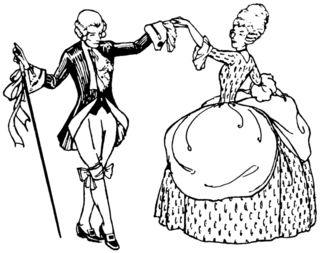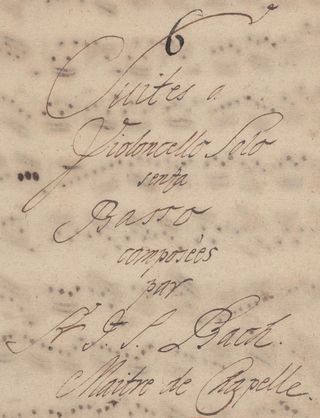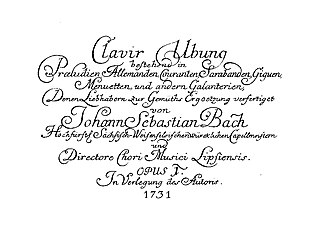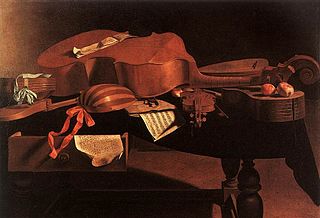
A minuet is a social dance of French origin for two people, usually written in 3
4 time but always played as if in 6
8 to reflect the step pattern of the dance. The English word was adapted from the Italian minuetto and the French menuet.
Ternary form, sometimes called song form, is a three-part musical form consisting of an opening section (A), a following section (B) and then a repetition of the first section (A). It is usually schematized as A–B–A. Prominent examples include the da capo aria "The trumpet shall sound" from Handel's Messiah, Chopin's Prelude in D-Flat Major "Raindrop", and the opening chorus of Bach's St John Passion.

A suite, in Western classical music, is an ordered set of instrumental or orchestral/concert band pieces. It originated in the late 14th century as a pairing of dance tunes; and grew in scope so that by the early 17th century it comprised up to five dances, sometimes with a prelude. The separate movements were often thematically and tonally linked. The term can also be used to refer to similar forms in other musical traditions, such as the Turkish fasıl and the Arab nuubaat.

The six Cello Suites, BWV 1007–1012, are suites for unaccompanied cello by Johann Sebastian Bach (1685–1750). They are some of the most frequently performed solo compositions ever written for cello. Bach most likely composed them during the period 1717–1723, when he served as Kapellmeister in Köthen. The title given on the cover of the Anna Magdalena Bach manuscript was Suites à Violoncello Solo senza Basso.
Because ballet became formalized in France, a significant part of ballet terminology is in the French language.

The gavotte is a French dance, taking its name from a folk dance of the Gavot, the people of the Pays de Gap region of Dauphiné in the southeast of France, where the dance originated, according to one source. According to another reference, the word gavotte is a generic term for a variety of French folk dances, and most likely originated in Lower Brittany in the west, or possibly Provence in the southeast or the French Basque Country in the southwest of France. It is notated in 4
4 or 2
2 time and is usually of moderate tempo, though the folk dances also use meters such as 9
8 and 5
8.

The sarabande is a dance in triple metre, or the music written for such a dance.
The minuet step is the dance step performed in the dance minuet. It "is composed of four plain straight Steps or Walks, and may be performed forwards, backward, sideways, &c." or in a square. The steps are often referred to by direction to distinguish them. "A Movement, or Sink and Rise, being added to the first Step of the three belonging to the Minuet Step, produces a Bouree; and the like to the fourth and last a Half Coupee, which together compose what is commonly called the English Minuet Step".

The passepied is a French court dance. Originating as a kind of Breton branle, it was adapted to courtly use in the 16th century and is found frequently in 18th-century French opera and ballet, particularly in pastoral scenes, and latterly also in baroque instrumental suites of dances. In English the passepied has been spelled "paspy" as well as "paspie" or "paspe", phonetic approximations of the French pronunciation.

The French Suites, BWV 812–817, are six suites which Johann Sebastian Bach wrote for the clavier between the years of 1722 and 1725. Although Suites Nos. 1 to 4 are typically dated to 1722, it is possible that the first was written somewhat earlier.

The four orchestral suites BWV 1066–1069 are four suites by Johann Sebastian Bach from the years 1724–1731. The name ouverture refers only in part to the opening movement in the style of the French overture, in which a majestic opening section in relatively slow dotted-note rhythm in duple meter is followed by a fast fugal section, then rounded off with a short recapitulation of the opening music. More broadly, the term was used in Baroque Germany for a suite of dance-pieces in French Baroque style preceded by such an ouverture. This genre was extremely popular in Germany during Bach's day, and he showed far less interest in it than was usual: Robin Stowell writes that "Telemann's 135 surviving examples [represent] only a fraction of those he is known to have written"; Christoph Graupner left 85; and Johann Friedrich Fasch left almost 100. Bach did write several other ouverture (suites) for solo instruments, notably the Cello Suite no. 5, BWV 1011, which also exists in the autograph Lute Suite in G minor, BWV 995, the Keyboard Partita no. 4 in D, BWV 828, and the Overture in the French style, BWV 831 for keyboard. The two keyboard works are among the few Bach published, and he prepared the lute suite for a "Monsieur Schouster," presumably for a fee, so all three may attest to the form's popularity.

Bourrée in E minor is a popular lute piece, the fifth movement from Suite in E minor BWV 996 written by Johann Sebastian Bach between 1708 and 1717. The piece is arguably one of the most famous among guitarists.
The Overture in the French style, BWV 831, original title Ouvertüre nach Französischer Art, also known as the French Overture and published as the second half of the Clavier-Übung II in 1735, is a suite in B minor for a two-manual harpsichord written by Johann Sebastian Bach.

The Minuets in G major and G minor, BWV Anh. 114 and 115, are a pair of movements from a suite for harpsichord by Christian Petzold, which, through their appearance in the 1725 Notebook for Anna Magdalena Bach, used to be attributed to Johann Sebastian Bach. These minuets, which are suitable for beginners on the piano, are among the best known pieces of music literature. The 1965 pop song "A Lover's Concerto", of which millions of copies were sold, is based on the first of these Minuets.

The term galanteries is sometimes used for movements in the Baroque dance suite whose inclusion is variable, unlike the fixed core of allemande, courante, sarabande and gigue. These pieces usually follow the sarabande.

Baroque music refers to the period or dominant style of Western classical music composed from about 1600 to 1750. The Baroque style followed the Renaissance period, and was followed in turn by the Classical period after a short transition. The Baroque period is divided into three major phases: early, middle, and late. Overlapping in time, they are conventionally dated from 1580 to 1650, from 1630 to 1700, and from 1680 to 1750. Baroque music forms a major portion of the "classical music" canon, and is widely studied, performed, and listened to. The term "baroque" comes from the Portuguese word barroco, meaning "misshapen pearl". The works of Antonio Vivaldi, George Frideric Handel and Johann Sebastian Bach are considered the pinnacle of the Baroque period. Other key composers of the Baroque era include Claudio Monteverdi, Domenico Scarlatti, Alessandro Scarlatti, Alessandro Stradella, Tomaso Albinoni, Johann Pachelbel, Henry Purcell, Georg Philipp Telemann, Jean-Baptiste Lully, Jean-Philippe Rameau, Marc-Antoine Charpentier, Arcangelo Corelli, François Couperin, Johann Hermann Schein, Heinrich Schütz, Samuel Scheidt, Dieterich Buxtehude, Gaspar Sanz, José de Nebra, Antonio Soler, Carlos Seixas, Adam Jarzębski and others, with Giovanni Battista Pergolesi being the most prominent Baroque composer of sacred music.
Suite in E minor, BWV 996, is a musical composition written by Johann Sebastian Bach (1685–1750) between 1708 and 1717. It is probable that this suite was intended for Lautenwerck (lute-harpsichord). Because the lautenwerk is an uncommon instrument, it is in modern times often performed on the guitar or the lute.

In dance and gymnastics, a turn is a rotation of the body about the vertical axis. It is usually a complete rotation of the body, although quarter (90°) and half (180°) turns are possible for some types of turns. Multiple, consecutive turns are typically named according to the number of 360° rotations.

The Water Music is a collection of orchestral movements, often published as three suites, composed by George Frideric Handel. It premiered on 17 July 1717, in response to King George I's request for a concert on the River Thames.

The conductor Sir Thomas Beecham made several orchestral suites from neglected music by George Frideric Handel, mostly from the composer's 42 surviving operas. The best known of the suites are The Gods Go a'Begging (1928), The Origin of Design (1932), The Faithful Shepherd (1940), Amaryllis (1944) and The Great Elopement.




















